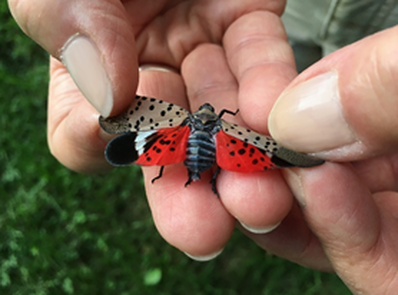|
By: Kristin Palilionis, Invasive Species Centre (ISC) A beautiful, bright red, showy invasive insect is making headlines in North America. It is known as the spotted lanternfly (SLF; Lycorma delicatula). It swarms by the hundreds to thousands, damages farm crops, and disrupts natural ecosystems. While it has not been found in Canada, we are concerned about the risk of introduction, as this notorious invasive species has been intercepted in two New York counties right across the border from Ontario’s Niagara region.  The spotted laternfly is an invasive planthopper native to Southeast Asia. It feeds on phloem tissue in plants which disrupts nutrient circulation. The preferred host, tree of heaven (Ailanthus altissima), another invasive species in North America, is found across southern Ontario. SLF also feed on over 70 species of trees and plants, including cultivated grapes, fruit trees, and hardwoods, making many environments vulnerable to SLF attack. Damage to trees from SLF feeding includes oozing sap, wilting, leaf curling, and tree dieback. SLF also excretes a sugary substance known as “honeydew” which rains from the canopy and, in high populations, will accumulate on or at the base of plants – fostering the growth of black sooty mould. These disturbances threaten Ontario’s multi-billion-dollar wine (viticulture), fruit, and forestry industries. Even more alarming is the ability for this species to spread. SLF was first detected in Berks County, Pennsylvania in September 2014. Six years later, populations have established in five additional states including New Jersey, Delaware, Maryland, Virginia, and New York and individuals have been detected (although no known infestations) in Massachusetts, Connecticut, and North Carolina. How does SLF spread? SLF can lay egg masses on almost any hard surface including vehicles, outdoor equipment, and patio furniture, which are then transported by humans to new locations. Egg masses carry 30-50 eggs per mass which are covered in a shiny, putty-like grey secretion that dulls, cracks, and remains viable over the winter. Egg masses are often disguised and easily hidden on materials and goods that we move around, increasing the potential for SLF to be unknowingly brought into Canada – an unwanted hitchhiker! The best way to avoid impacts of SLF in Canada is to keep it out! Investing time and efforts in prevention will help reduce potential long-term economic costs and protect our environment. Everyone in Canada plays an important role in detecting, reporting, and amplifying invasive species awareness. Citizen/Community scientists, and particularly informed members of the public, such as members from the Biodiversity Education and Awareness Network (BEAN), can act as early detectors of invasive species and are invaluable in efforts to prevent SLF from entering and establishing in Ontario. Here are ways you can help protect Canada’s biodiversity by keeping SLF out:
The Invasive Species Centre (ISC) is a non-for-profit organization that prevents the introduction and spread of invasive species in Canada by connecting stakeholders with knowledge and technology. Through species profiles, monthly webinars, best management practices, management services, fact sheets, and blog posts like this one, we create a hub for collaboration and knowledge sharing to protect Canada’s natural environment. For more information on SLF, make sure to check out our SLF fact sheet, poster, and webinar and share these resources with friends and family! The more eyes we have, the better chances we have in keeping this species out of Canada. Learn more about invasive species threatening Canada’s natural spaces by signing up to receive bi-weekly email updates on recent invasive species media and research, information on upcoming events and a quarterly newsletter from the Invasive Species Centre.
0 Comments
Leave a Reply. |
AuthorWrite something about yourself. No need to be fancy, just an overview. Archives
July 2024
Categories |

 RSS Feed
RSS Feed
